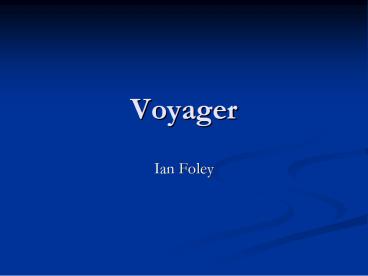Voyager - PowerPoint PPT Presentation
1 / 12
Title: Voyager
1
Voyager
- Ian Foley
2
Table of Contents
- Preliminary Information
- Voyagers Objectives
- Equipment
- Planetary Tour
- Interstellar Mission
- Interesting Facts
3
Preliminary Information
- Voyager 2 launched on August 20th, 1977
- Voyager 1 launched on September 5th, 1977
- Both were launched in Titan-Centaur expendable
rockets - Designed to use the gravity of the planets it
visited to accelerate to minimize the amount of
fuel consumed and trip time. - After a proposed 10,000 trajectories, scientists
chose trajectories that allowed fly-bys of
Jupiter and its moon Io and Saturn and its moon
Titan - Initially built to last for five years.
4
Voyagers Objectives
- Initial Mission To explore Jupiter and Saturn
- Extended Mission To explore Uranus and Neptune
- Current Mission the Voyage Interstellar mission,
which will explore the outermost edge of the
suns domain
5
Equipment
- 3 axis stabilizing systems
- Ultraviolet spectrometer
- Radiometer
- Infared spectrometer
- Flight data subsystem and an 8 track digital tape
recorder. - Command computer subsystem
- Altitude and articulation control system
- S-band and x-band communicators
- Three radioisotope thermoelectric generators.
- Magnometer
- Wide and narrow angle cameras
6
Jupiter
- Voyager 1s closest approach March 5th, 1979
- Voyager 2s closest approach July 9th, 1979
- Voyager 1 took 19,000 photographs of Jupiter, all
of which exceeded the best pictures taken from
Earth - Voyager 2 took over 33,000 pictures of Jupiter
and its five major satellites - Voyager discovered an additional three
satellites - Voyager 1 observed 9 erupting volcanoes on Io
- Voyager 1 obtained the first image of Jupiters
rings - Voyager 2 discovered the rings were about 4000
miles wide.
7
Saturn
- Voyager 1 encountered Saturn in November 1980
- Voyager 2 encountered Saturn in August 1981
- Voyager 1 and 2 both measured a day on Saturn to
be 10 hours, 39 minutes long. - Discovered that Saturn was 75 Hydrogen and 25
Helium - Learned that Saturn has an equatorial jet stream
blowing up to 1,100 MPH - Main objective was to study Titan, but Titans
haze prevented Voyager to take pictures of its
surface. - Discovered Titans atmosphere consisted of mainly
Nitrogen, and that its atmosphere is 1.6 times as
dense as the Earths - Scientists theorize that Titans atmosphere
resembles a pre-evolutionary Earth
8
Uranus
- Voyager 2 flew within 50,600 miles of Uranus on
January 14th, 1986. - Measured a day on Uranus to be 17 hours, 14
minutes. - Discovered Uranus has a strong magnetic field
that is tilted so that the magnetic poles are
close to the equator. - Discovered a new ring and dust system that is
only visible when backlit by the sun. - Discovered ten new moons surrounding Uranus.
9
Neptune
- Closest flyby on August 25, 1989.
- Discovered that Neptune was the densest planet
out of the giant planets. - Has westward wind gusts of up to 1,500 MPH, the
fastest in the solar system. - Detected periodic radio emissions indicating a
strong magnetic field. - Determined a day to be 16 hours, 7 minutes.
- Detected three rings circling Neptune.
- Discovered six new satellites Proteus, Larissa,
Despina, Galetea, Thalassa, and Naiad.
10
Interstellar Mission
- Both Voyagers are headed toward the heliopause,
an area where the suns influence wanes and the
beginnings of interstellar space can be felt. - In the next five years they will reach the
termination shock, an area where solar winds
drastically reduce. - Voyager should cross the heliopause ten to
fifteen years after reaching the termination
shock. - Voyagers have enough electrical power and
thruster fuel to last until the year 2020
11
Interesting Facts
- A golden record is on board the spacecraft
including greetings, music, and images from
Earth. - 11,000 work years have been dedicated to Voyager
through the Neptune encounter - Total cost 865,000,000
- Voyagers cameras are sharp enough to read a
newspaper one kilometer away. - The accuracy of sending a radio signal from
Neptune to Earth is the equivalent of 2260 mile
golf put.
12
Sources
- http//voyager.jpl.nasa.gov/index.html
- http//spacephysics.ucr.edu/index.php































